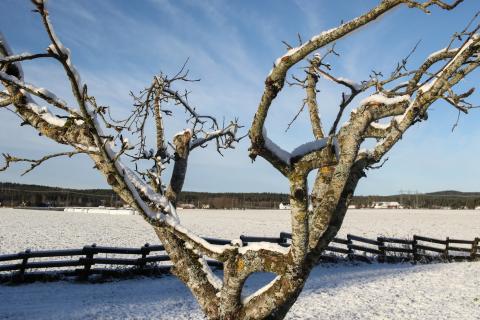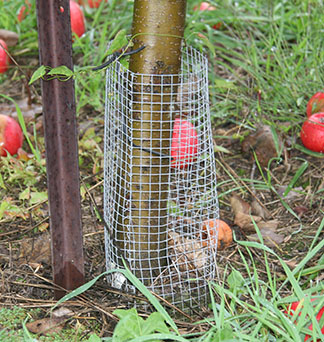How do I prepare my backyard fruits for winter?

The 2020 growing season has been challenging for backyard and commercial fruit growers alike, with drought taking its toll. Fall is the time for some important chores in the backyard orchard and berry patch, but too often home growers forget their fruits once the harvest is done.
Impact of Drought
When drought occurs within approximately eight weeks after bloom for a crop like apples, there can be an impact on development of buds for the following year. Summer drought can likewise impact the development of the following year's buds. For a crop like peaches, the fruits develop on one year-old wood, which means that you need a good amount of growth each year to ensure a good crop the following year. This is all to say that preparing backyard fruits for winter goes a long way, but still leaves some of next year's success up to weather conditions from earlier this growing season and next growing season.
Tree Fruits
The primary tree fruits grown in New Hampshire backyards are apples, pears, peaches, nectarines, apricots, plums and sweet and tart cherries.
After the harvest concludes, fruit trees begin a process of hardening off to prepare for winter. Home orchardists don't want to do anything to interfere with that process. Some practices to avoid are:
- Fall fertilizing with products containing nitrogen or phosphorus. You want to avoid fertilizing with products containing nitrogen after the beginning of July, including compost or manure.
- Pruning, with the exception of cutting dead wood. If a branch is broken, make a clean cut but plan to cut to the branch collar in the early spring.
- Spraying, with the exception of copper sulfate for fire blight and peach leaf curl on peaches and nectarines. Copper sulfate should only be sprayed in the fall on trees that have had fire blight or peach leaf curl. Reach out to the UNH Extension Infoline for more specific recommendations, and consult the home fruit spray schedule.
- Fertilizing your lawn within 20 feet of your fruit trees in the fall, because the nitrogen in your lawn fertilizer could delay your fruit trees hardening off.
Sanitation
For all of these tree fruits, removing any fruit remaining on the tree or that has fallen to the ground is a must. This practice will help reduce disease or insect problems for next year's growing season.
For apples especially, it's important to rake up fallen leaves around the tree. It's not a bad idea to do this for pears and stone fruits as well, but it's most important for apples because a common fungal disease, apple scab, overwinters in the leaf debris under the trees. While somewhat weather dependent, the disease will infect new growth on the apple tree in the spring unless it's removed.
As long as you're not using your compost around fruit trees, you can add this material to your compost pile. If you use your compost throughout your garden and landscape, including your fruits, avoid adding this material to your compost pile because most homemade compost doesn't reach sustained temperatures necessary to kill disease causing organisms that could infect your fruits.
Sanitation is easier if you keep weeds and grass down around your trees.
Painting The Trunks White
Young fruit trees are susceptible to winter injury in New Hampshire, especially bark splitting after warm and sunny winter days when the tree bark expands and then contracts when temperatures drop suddenly at night.

To prevent tree bark splitting, apply a light coat of exterior white latex paint, mixed with water in a 50/50 ratio. Paint the lower 24 to 36 inches of the tree trunk in the late fall. You can paint the entire trunk, but the south and west sides of the trunk are most important. The painted surface will help by reflecting the sun's rays away from the tree trunk. By reflecting the sun's rays, you reduce the fluctuation of the tree bark's temperature. We recommend repainting every two years.
Tree Guards
Tree guards are an important tool for protecting fruit trees from voles, a small rodent that damages a wide variety of garden and landscape plants. Voles will damage and potentially girdle the bark of fruit trees, which can harm them. Young trees are most susceptible to injury, but vole damage can occur with mature fruit trees as well.
We recommend using 1/4 inch mesh galvanized hardware cloth, but plastic mesh is another material that can be used. Hardware cloth and plastic mesh guards can be left in place, whereas plastic tubing and plastic tree wraps should be put on in November and removed in early spring. The guard should be buried about 1 to 4 inches into the ground, which is easiest to do at planting, and should be at least 18 inches tall.

George Hamilton recommends the use of pea gravel between the trunk and the guard. Leaves should be cleared out of the guards, and you should be able to see the base of the tree through the guard.
Small Fruits
The primary small fruits planted and grown in New Hampshire gardens are blackberries, blueberries, grapes, raspberries and strawberries. Increasingly, gardeners are also growing kiwiberries, but those are unique small fruits and are discussed separately.
Strawberries
To protect strawberries from winter injury and prevent winter heaving, spread a weed-free mulch over your planting. Clean straw or salt marsh hay is ideal mulching material, but other light organic mulch options can be used as well. Apply mulch material after the ground freezes, usually mid to late November. It's important to not apply the mulch too early. While snow cover makes for the best winter protection, we can't count on a consistent snow cover throughout the winter. Aim for 3 to 6 inches of mulch, and try and apply before rain so the mulch will get wetted down. Remove your mulch by April 1.
Strawberries should not be transplanted after mid-September in southern New Hampshire or the beginning of September in northern New Hampshire. Rows can be cleaned up and pruned out of pathways, but it's best to avoid significant pruning in the fall.
Blueberries
Highbush blueberries have a shallow root system and should be mulched 3 to 4 inches deep. Wood chips, bark, pine needles, leaves, or combinations of these all make good mulch. Sawdust can also be used. Moisten soil before applying mulch, and when you mulch do so evenly and avoid piling mulch up against the trunk of the plant.
If you have had issues with a fungal disease called mummyberry, which causes berries to mummify (they have been described as looking like miniature black pumpkins), it's especially important to mulch well.
Avoid fertilizing blueberries after July 1 in New Hampshire, but pH can be amended anytime in accordance with soil test recommendations.
If you have had issues with voles in your blueberry patch, try using snap traps baited with fragrant apple in active runways around your plants. Voles can be a significant pest of blueberries, so it's important to reduce populations with trapping. Vole issues can be especially significant for blueberries grown on woodland borders.
If you grow blueberries in containers, they should not only be well mulched but moved to a more protected area that’s less exposed to prevailing winter winds.
If you grow lowbush blueberries, you can wait until early spring for pruning or do a controlled burn in the fall after the leaves have fallen off.
Brambles: Raspberries and Blackberries
For red and yellow raspberries that produce a crop once a year in June and July (summer bearers), spent canes should be cut out in summer or fall. Other pruning should be done in the early spring. Summer bearers should not be mowed to the ground.
For fall bearing (everbearing) red and yellow raspberries, they can be mowed to the ground in either the late fall or early spring. This will forfeit the spring crop, but is an easier way of maintaining red raspberries that produce in the fall.
It's helpful to make a note of when your raspberries are producing so you know how to handle them in the fall and early spring.
For black and purple raspberries, which should be trained and tied to a trellis, you can thin some weaker canes in the fall, but most pruning and selection of canes should be done in the spring.
Blackberries are similar to black raspberries. They can be pinched throughout the growing season, and then mowed to the ground in the late fall. Blackberries canes can be buried under mulch to prevent winter injury in the late winter or early spring.
While too late now, it may be worth planting a cover crop in the late summer, such as spring oats, in your bramble patch. A cover crop will help your brambles harden-off properly by using excess water and nutrients in the soil while suppressing weed growth.
Grapes
It's important to remove all grapes from the vines in the fall to manage a common and challenging fungal disease called black rot. It's easiest to remove grapes once the leaves have fallen off in the late fall.
You can do light pruning, but shouldn't do any hard pruning because you may be cutting off canes with fruiting potential for next year.
Mulch can provide habitat for voles, so it's not necessary to mulch grapes. If you do mulch, keep at least 5 inches of distance between the mulch and the base of the plant. Snap traps can be deployed to reduce vole populations.
If you are growing grapes near a lawn, be careful about using broad-leaf herbicides, especially anything containing 2,4-D, because grapes are especially sensitive to these herbicides. You may not see evidence of damage until spring, but broadleaf herbicides (including in a "weed and feed" product) can pose a risk to nearby grapes.
Planning for Next Year
The fall is a great time of year to get your soil tested, which UNH Extension recommends every three years. Soil testing includes recommendations for adjusting pH and nutrient levels to optimal levels for backyard fruit health and production.
If you are planning on planting tree fruits or berries in the spring, it's especially important to get your soil tested so you can adjust your pH to optimal levels in the fall. You may want to place your order for your fruit in the late fall, either from a reputable online retailer or a reputable local garden center or nursery. Visit their websites or contact them directly to inquire about selection, so you can purchase the variety and rootstock you want. Prepare your planting site in the fall and plant in the early spring after the danger of severe frost is past and the soil is dry enough to be prepared.
Watch An Interview with George Hamilton on Preparing Fruit Trees for Winter
Got questions? The Ask UNH Extension Infoline offers practical help finding answers for your home, yard, and garden questions. Call toll free at 1-877-398-4769, Monday to Friday, 9 a.m. to 2 p.m., or e-mail us at answers@unh.edu.
Related Resource(s)
Do you love learning about stuff like this?
SUBSCRIBE TO Granite State Gardening newsletter
Got questions? The UNH Extension Yard and Garden Infoline offers practical help finding answers for your yard and garden questions.
Call toll free at 1-877-398-4769, Monday to Friday, 9 a.m. to 2 p.m., or fill out webform.

